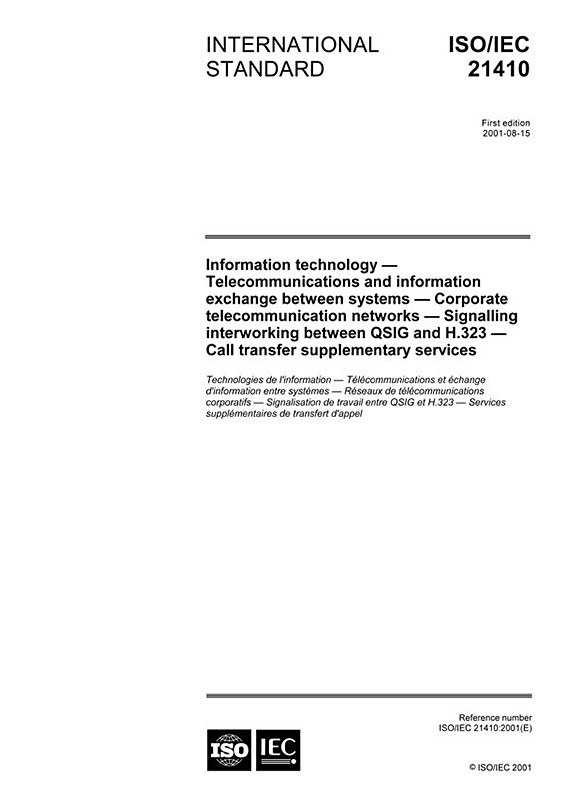ISO/IEC 21410:2001
Information technology - Telecommunications and information exchange between systems - Corporate telecommunication networks - Signalling interworking between QSIG and H.323 - Call transfer supplementary services
Ausgabedatum:
2001-08
Edition:
1.0
Sprache: EN - englisch
Seitenzahl: 50 VDE-Artnr.: 215539
This International Standard specifies signalling interworking between 'QSIG' and 'H.323' in support of the call transfer
supplementary services within a Corporate telecommunication Network (CN).
'QSIG' is a signalling protocol that operates at the Q reference point between Private Integrated Services eXchanges (PINX)
within a Private Integrated Services Network (PISN). The Q reference point is defined in ISO/IEC 11579-1. A PISN provides
circuit-switched basic services and supplementary services to its users. QSIG is specified in other Standards, in particular
ISO/IEC 11572 (call control in support of basic services), ISO/IEC 11582 (generic functional protocol for the support of
supplementary services) and a number of standards specifying individual supplementary services. ISO/IEC 13869 specifies the
QSIG protocol in support of call transfer by consultation and ISO/IEC 19460 specifies the QSIG protocol in support of single
step call transfer.
'H.323' is a set of signalling protocols for the support of voice or multimedia communication within a packet network, in
particular a packet network that uses the Internet Protocol (IP) as its network layer protocol (IP network). H.323 signalling
protocols operate between endpoints in an IP network, either indirectly via one or more gatekeepers, or directly. An endpoint
can be a terminal or a gateway to another network. H.323 is an 'umbrella' recommendation referring to various ITU-T
recommendations, in particular Recommendations H.225.0 and H.245 (basic communication capabilities) and
Recommendation H.450.1 (generic functional protocol for the support of supplementary services). Recommendation H.450.2
specifies the H.323 protocol in support of call transfer.
NOTE - H.450.2 applies only to the 1998 version of H.323 (also known as H.323 version 2) and to later versions.
Call transfer by consultation, as supported by ISO/IEC 13869, is a supplementary service that enables a user (user A) to
transform two of that user's calls (at least one of which must be answered) into a new call between the two other users in the two
calls (users B and C).
Single step call transfer, as supported by ISO/IEC 19460, is a supplementary service that enables a user (user A) to transform
an existing call between user A and user B into a new call between user B and user C without user A needing to establish a call
with user C prior to transfer.
Call transfer, as supported by H.450.2, is a supplementary service that enables the served user (user A) to transform an existing
call with a second user (user B) into a new call between user B and a third user (user C) selected by user A. User A may or may
not have a call established with user C prior to call transfer. If a call is already established between user A and user C, this is
known as transfer by consultation and is equivalent to call transfer as supported by ISO/IEC 13869. If a call is not already
established between user A and user C, this is known as single step call transfer and is equivalent to call transfer as supported
by ISO/IEC 19460.
Interworking between QSIG and H.323 permits a call originating at a user of a PISN to terminate at a user of an IP network, or
a call originating at a user of an IP network to terminate at a user of a PISN. This International Standard provides the following
additional capabilities:
_ a PISN user with two calls established, at least one of which being to or from a user in an IP network, to be able to
transform those two calls into a new call between the other two users involved;
_ a PISN user with a call established to or from a user in an IP network to be able to transform that call into a new call
between the IP network user and a third user selected by the PISN user, that third user being either in the IP network or in
the PISN;
_ a PISN user with a call established to a second PISN user to be able to transfer that call into a new call between the second
user and a third user selected by the first user, that third user being in an IP network;
_ an IP network user with two calls established, at least one of which being to or from a user in a PISN, to be able to
transform those two calls into a new call between the other two users involved;
_ an IP network user with a call established to or from a user in a PISN to be able to transform that call into a new call
between the PISN user and a third user selected by the IP network user, that third user being either in the IP network or in
the PISN; and
ISO/IEC 21410:2001(E)
2 © ISO/IEC 2001 ? All rights reserved
_ an IP network user with a call established to a second user in the IP network to be able to transfer that call into a new call
between the second user and a third user selected by the first user, that third user being in a PISN.
This International Standard is applicable to any interworking unit that can act as a gateway between a PISN employing QSIG
and an IP network employing H.323.


